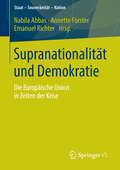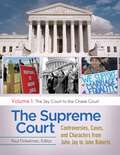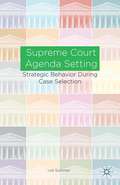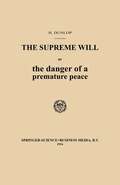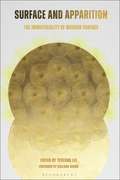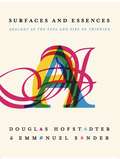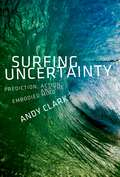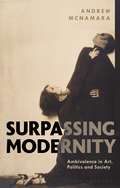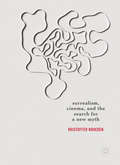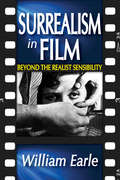- Table View
- List View
Supranationalität und Demokratie: Die Europäische Union in Zeiten der Krise (Staat – Souveränität – Nation #0)
by Nabila Abbas Annette Förster Emanuel RichterEuropa steht vor der Alternative, sich in intergouvernementales Regieren zurückzubilden oder eine starke supranationale Regulierungsbehörde zu schaffen, die autoritativ auf die nationale Politik und Rechtssetzung einwirkt. Beide Alternativen bieten keine viel versprechenden Aussichten auf eine partizipative Demokratie auf supranationaler Ebene. Der Sammelband soll vor diesem Hintergrund in aller Skepsis und Kritik die verbleibenden Optionen der Demokratie in der Europäischen Union aufzeigen.
The Supreme Court [4 volumes]: Controversies, Cases, and Characters from John Jay to John Roberts [4 volumes]
by Paul FinkelmanAn insightful, chronological—by chief justice—examination of the Supreme Court that enables students and readers to understand and appreciate the constitutional role the Court plays in American government and society.American citizens need to understand the importance of the Supreme Court in determining how our government and society operates, regardless of whether or not they agree with the Court's opinions. Unfortunately, the role and powers of the third branch of government are not well understood by the American public. After an introduction and overview to the history of the Supreme Court from 1789 to 2013, this book examines the Court's decisions chronologically by Chief Justice, allowing readers to grasp how the role and powers of the Court have developed and shifted over time. The chapters depict the Court as the essential agent of review and an integrated part of the government, regardless of the majority/minority balance on the Court, and of which political party is in the White House or controlling the House or Senate.
The Supreme Court [4 volumes]: Controversies, Cases, and Characters from John Jay to John Roberts [4 volumes]
An insightful, chronological—by chief justice—examination of the Supreme Court that enables students and readers to understand and appreciate the constitutional role the Court plays in American government and society.American citizens need to understand the importance of the Supreme Court in determining how our government and society operates, regardless of whether or not they agree with the Court's opinions. Unfortunately, the role and powers of the third branch of government are not well understood by the American public. After an introduction and overview to the history of the Supreme Court from 1789 to 2013, this book examines the Court's decisions chronologically by Chief Justice, allowing readers to grasp how the role and powers of the Court have developed and shifted over time. The chapters depict the Court as the essential agent of review and an integrated part of the government, regardless of the majority/minority balance on the Court, and of which political party is in the White House or controlling the House or Senate.
Supreme Court Agenda Setting: Strategic Behavior during Case Selection
by U. SommerMuch research is devoted to the decision-making power and precedent set by the Supreme Court. Less attention, however, is given to the strategic behavior during case selection. This book argues that case selection is done strategically, and by means of various criteria - influencing its constitutional position and importance.
Supreme Doctrine: Psychological Studies in Zen Thought; 2nd edition
by Hubert BenoitA classic text on what Zen thought had to offer the practising Western psychiatrist.
Surface and Apparition: The Immateriality of Modern Surface
by Yeseung LeeSurface is one of the most intensely debated topics in recent arts, humanities and social science scholarship. The changing technologies which manufacture the actual and virtual surfaces of today are radically altering our perception of thresholds and borders. In contrast to the responses to preceding industrial revolutions, contemporary concerns with surface seem preoccupied with its function of mediation or passage, rather than with that of separation or boundary. In Surface and Apparition, each chapter explores a different meaning and function of the material and immaterial qualities of 'surface'.Case studies include various surfaces from computer screens, 'artisanal' engines and glass architecture to gauzy veils, the planetary surface of supply chain capitalism, and spatial embodiment in street markets. International scholars of design, architecture, film, media, fine art, fashion, textiles, silversmithing, woodworking and archival practices account for how the material and the immaterial draw attention to each other in both their everyday and artistic practice. Each chapter addresses particular systems (from the human body to manually operated tools and machines); materials (for instance cloth, wood and light); modes of attention, movement and engagement. 'Surface' therefore functions in this book as a multidisciplinary method for attending to critical issues concerning human creative and technological endeavours.
Surface and Apparition: The Immateriality of Modern Surface
Surface is one of the most intensely debated topics in recent arts, humanities and social science scholarship. The changing technologies which manufacture the actual and virtual surfaces of today are radically altering our perception of thresholds and borders. In contrast to the responses to preceding industrial revolutions, contemporary concerns with surface seem preoccupied with its function of mediation or passage, rather than with that of separation or boundary. In Surface and Apparition, each chapter explores a different meaning and function of the material and immaterial qualities of 'surface'.Case studies include various surfaces from computer screens, 'artisanal' engines and glass architecture to gauzy veils, the planetary surface of supply chain capitalism, and spatial embodiment in street markets. International scholars of design, architecture, film, media, fine art, fashion, textiles, silversmithing, woodworking and archival practices account for how the material and the immaterial draw attention to each other in both their everyday and artistic practice. Each chapter addresses particular systems (from the human body to manually operated tools and machines); materials (for instance cloth, wood and light); modes of attention, movement and engagement. 'Surface' therefore functions in this book as a multidisciplinary method for attending to critical issues concerning human creative and technological endeavours.
Surfaces and Essences: Analogy as the Fuel and Fire of Thinking
by Douglas Hofstadter Emmanuel SanderIs there one central mechanism upon which all human thinking rests? Cognitive scientists Douglas Hofstadter and Emmanuel Sander argue that there is. At this core is our incessant proclivity to take what we perceive, to abstract it, and to find resemblances to prior experiences—in other words, our ability to make analogies.In The Essence of Thought, Hofstadter and Sander show how analogy-making pervades our thought at all levels—indeed, that we make analogies not once a day or once an hour, but many times per second. Thus, analogy is the mechanism that, silently and hidden, chooses our words and phrases for us when we speak, frames how we understand the most banal everyday situation, guides us in unfamiliar situations, and gives rise to great acts of imagination.We categorize because of analogies that range from simple to subtle, and thus our categories, throughout our lives, expand and grow ever more fluid. Through examples galore and lively prose peppered, needless to say, with analogies large and small, Hofstadter and Sander offer us a new way of thinking about thinking.
Surfing through Hyperspace: Understanding Higher Universes in Six Easy Lessons
by Clifford A. PickoverDo a little armchair time-travel, rub elbows with a four-dimensional intelligent life form, or stretch your mind to the furthest corner of an uncharted universe. With this astonishing guidebook, Surfing Through Hyperspace, you need not be a mathematician or an astrophysicist to explore the all-but-unfathomable concepts of hyperspace and higher-dimensional geometry. No subject in mathematics has intrigued both children and adults as much as the idea of a fourth dimension. Philosophers and parapsychologists have meditated on this mysterious space that no one can point to but may be all around us. Yet this extra dimension has a very real, practical value to mathematicians and physicists who use it every day in their calculations. In the tradition of Flatland, and with an infectious enthusiasm, Clifford Pickover tackles the problems inherent in our 3-D brains trying to visualize a 4-D world, muses on the religious implications of the existence of higher-dimensional consciousness, and urges all curious readers to venture into "the unexplored territory lying beyond the prison of the obvious." Pickover alternates sections that explain the science of hyperspace with sections that dramatize mind-expanding concepts through a fictional dialogue between two futuristic FBI agents who dabble in the fourth dimension as a matter of national security. This highly accessible and entertaining approach turns an intimidating subject into a scientific game open to all dreamers. Surfing Through Hyperspace concludes with a number of puzzles, computer experiments and formulas for further exploration, inviting readers to extend their minds across this inexhaustibly intriguing scientific terrain.
Surfing through Hyperspace: Understanding Higher Universes in Six Easy Lessons
by Clifford A. PickoverDo a little armchair time-travel, rub elbows with a four-dimensional intelligent life form, or stretch your mind to the furthest corner of an uncharted universe. With this astonishing guidebook, Surfing Through Hyperspace, you need not be a mathematician or an astrophysicist to explore the all-but-unfathomable concepts of hyperspace and higher-dimensional geometry. No subject in mathematics has intrigued both children and adults as much as the idea of a fourth dimension. Philosophers and parapsychologists have meditated on this mysterious space that no one can point to but may be all around us. Yet this extra dimension has a very real, practical value to mathematicians and physicists who use it every day in their calculations. In the tradition of Flatland, and with an infectious enthusiasm, Clifford Pickover tackles the problems inherent in our 3-D brains trying to visualize a 4-D world, muses on the religious implications of the existence of higher-dimensional consciousness, and urges all curious readers to venture into "the unexplored territory lying beyond the prison of the obvious." Pickover alternates sections that explain the science of hyperspace with sections that dramatize mind-expanding concepts through a fictional dialogue between two futuristic FBI agents who dabble in the fourth dimension as a matter of national security. This highly accessible and entertaining approach turns an intimidating subject into a scientific game open to all dreamers. Surfing Through Hyperspace concludes with a number of puzzles, computer experiments and formulas for further exploration, inviting readers to extend their minds across this inexhaustibly intriguing scientific terrain.
Surfing Uncertainty: Prediction, Action, and the Embodied Mind
by Andy ClarkHow is it that thoroughly physical material beings such as ourselves can think, dream, feel, create and understand ideas, theories and concepts? How does mere matter give rise to all these non-material mental states, including consciousness itself? An answer to this central question of our existence is emerging at the busy intersection of neuroscience, psychology, artificial intelligence, and robotics. In this groundbreaking work, philosopher and cognitive scientist Andy Clark explores exciting new theories from these fields that reveal minds like ours to be prediction machines - devices that have evolved to anticipate the incoming streams of sensory stimulation before they arrive. These predictions then initiate actions that structure our worlds and alter the very things we need to engage and predict. Clark takes us on a journey in discovering the circular causal flows and the self-structuring of the environment that define "the predictive brain." What emerges is a bold, new, cutting-edge vision that reveals the brain as our driving force in the daily surf through the waves of sensory stimulation.
Surfing Uncertainty: Prediction, Action, and the Embodied Mind
by Andy ClarkHow is it that thoroughly physical material beings such as ourselves can think, dream, feel, create and understand ideas, theories and concepts? How does mere matter give rise to all these non-material mental states, including consciousness itself? An answer to this central question of our existence is emerging at the busy intersection of neuroscience, psychology, artificial intelligence, and robotics. In this groundbreaking work, philosopher and cognitive scientist Andy Clark explores exciting new theories from these fields that reveal minds like ours to be prediction machines - devices that have evolved to anticipate the incoming streams of sensory stimulation before they arrive. These predictions then initiate actions that structure our worlds and alter the very things we need to engage and predict. Clark takes us on a journey in discovering the circular causal flows and the self-structuring of the environment that define "the predictive brain." What emerges is a bold, new, cutting-edge vision that reveals the brain as our driving force in the daily surf through the waves of sensory stimulation.
Surgical Ethics: Principles and Practice
by Alberto R. FerreresThis book encompasses the theoretical and practical aspects of surgical ethics, with a focus on the application of ethical standards to everyday surgical practice and the resolution of ethical conflicts in the surgical arena. It provides surgeons (both prospective and practicing) in the different surgical fields with deep, practical insights into the topic. A 21st century surgeon requires complete competence (superb clinical skills, expert surgical decision-making and outstanding performance and technical skills) as well as solid ethical values. Ethics are placed at the core of surgical professionalism, so surgeons must be not only proficient and expert but also ethically and morally reliable. Surgical decision-making can be considered as a two-step process: the “how to treat” aspect is a matter of surgical science, while “why to treat” issues are a matter of surgical ethics and are based on ethical principles. As such, every surgeon should have a moral compass to guide his or her actions, always placing the welfare and rights of the patients above their own. The book provides invaluable background and insights for solving the ethical conflicts surgeons around the globe encounter in their daily practice.Each chapter will also include features such as key point summaries in the beginning of the chapters, explanatory boxes, a glossary and suggested readings. Surgical Ethics - Principles and Practice is an authoritative work in the field designed for experienced surgeons, surgical residents, and fellows, all of whom are confronted with ethics issues and conflicts in practice.
Surging Democracy: Notes on Hannah Arendt’s Political Thought
by Adriana CavareroWhat does a truly democratic experience of political action look like today? In this provocative new work, Adriana Cavarero weighs in on contemporary debates about the relationship between democracy, happiness, and dissent. Drawing on Arendt's understanding of politics as a participatory experience, but also discussing texts by Émile Zola, Elias Canetti, Boris Pasternak, and Roland Barthes, along with engaging Judith Butler, Cavarero proposes a new view of democracy, based not on violence, but rather on the spontaneous experience of a plurality of bodies coming together in public. Expanding on the themes explored in previous works, Cavarero offers a timely intervention into current thinking about the nature of democracy, suggesting that its emergence thrives on the nonviolent creativity of a widespread, participatory, and relational power that is shared horizontally rather than vertically. From digital democracy to selfies to contemporary protest movements, Cavarero argues that we need to rethink our focus on individual happiness and turn toward rediscovering the joyful emotions of birth through plural interaction. Yes, let us be happy, she urges, but let us do so publicly, politically, together.
Surpassing Modernity: Ambivalence in Art, Politics and Society
by Andrew McNamaraFor the past thirty to forty years, cultural analysis has focused on developing terms to explain the surpassing of modernity. Discussion is stranded in an impasse between those who view the term modernity with automatic disdain-as deterministic, Eurocentric or imperialistic-and a booming interest that is renewing the study of modernism. Another dilemma is that the urge to move away from, or beyond, modernity arises because it is viewed as difficult, even unsavoury. Yet, there has always been a view of modernity as somehow difficult to live with, and that has been said by figures we regard today as typical modernists. McNamara argues in this book that it is time to forget the quest to surpass modernity. Instead, we should re-examine a legacy that continues to inform our artistic conceptions, our political debates, our critical justifications, even if that legacy is baffling and contradictory. We may find it difficult to live with, but without recourse to this legacy, our critical-cultural ambitions would remain seriously diminished.How do we explain the culture we live in today? And how do we, as citizens, make sense of it? This book suggests these questions have become increasingly difficult to answer.
Surpassing Modernity: Ambivalence in Art, Politics and Society
by Andrew McNamaraFor the past thirty to forty years, cultural analysis has focused on developing terms to explain the surpassing of modernity. Discussion is stranded in an impasse between those who view the term modernity with automatic disdain-as deterministic, Eurocentric or imperialistic-and a booming interest that is renewing the study of modernism. Another dilemma is that the urge to move away from, or beyond, modernity arises because it is viewed as difficult, even unsavoury. Yet, there has always been a view of modernity as somehow difficult to live with, and that has been said by figures we regard today as typical modernists. McNamara argues in this book that it is time to forget the quest to surpass modernity. Instead, we should re-examine a legacy that continues to inform our artistic conceptions, our political debates, our critical justifications, even if that legacy is baffling and contradictory. We may find it difficult to live with, but without recourse to this legacy, our critical-cultural ambitions would remain seriously diminished.How do we explain the culture we live in today? And how do we, as citizens, make sense of it? This book suggests these questions have become increasingly difficult to answer.
Surplus-Enjoyment: A Guide For The Non-Perplexed
by Slavoj ŽižekContemporary life is defined by excess. There must always be more, there is never enough. We need a surplus to what we need to be able to truly enjoy what we have. Slavoj Žižek's guide to surplus (and why it's enjoyable) begins by arguing that what is surplus to our needs is by its very nature unsubstantial and unnecessary. But, perversely, without this surplus, we wouldn't be able to enjoy, what is substantial and necessary. Indeed, without the surplus we wouldn't be able to identify what was the perfect amount. Is there any escape from the vicious cycle of surplus enjoyment or are we forever doomed to simply want more? Engaging with everything from The Joker film to pop songs and Thomas Aquinas to the history of pandemics, Žižek argues that recognising the society of enjoyment we live in for what it is can provide an explanation for the political impasses in which we find ourselves today. And if we begin, even a little bit, to recognise that the nuggets of 'enjoyment' we find in excess are as flimsy and futile, might we find a way out?
Surplus-Enjoyment: A Guide For The Non-Perplexed
by Slavoj ŽižekContemporary life is defined by excess. There must always be more, there is never enough. We need a surplus to what we need to be able to truly enjoy what we have. Slavoj Žižek's guide to surplus (and why it's enjoyable) begins by arguing that what is surplus to our needs is by its very nature unsubstantial and unnecessary. But, perversely, without this surplus, we wouldn't be able to enjoy, what is substantial and necessary. Indeed, without the surplus we wouldn't be able to identify what was the perfect amount. Is there any escape from the vicious cycle of surplus enjoyment or are we forever doomed to simply want more? Engaging with everything from The Joker film to pop songs and Thomas Aquinas to the history of pandemics, Žižek argues that recognising the society of enjoyment we live in for what it is can provide an explanation for the political impasses in which we find ourselves today. And if we begin, even a little bit, to recognise that the nuggets of 'enjoyment' we find in excess are as flimsy and futile, might we find a way out?
Surprise: An Emotion? (Contributions To Phenomenology #97)
by Natalie Depraz Anthony J. SteinbockThis volume offers perspectives on the theme of surprise crossing philosophical, phenomenological, scientific, psycho-physiology, psychiatric, and linguistic boundaries. The main question it examines is whether surprise is an emotion. It uses two main theoretical frameworks to do so: psychology, in which surprise is commonly considered a primary emotion, and philosophy, in which surprise is related to passions as opposed to reason. The book explores whether these views on surprise are satisfying or sufficient. It looks at the extent to which surprise is also a cognitive phenomenon and primitively embedded in language, and the way in which surprise is connected to personhood, the interpersonal, and moral emotions. Many philosophers of different traditions, a number of experimental studies conducted over the last decades, recent works in linguistics, and ancestral wisdom testimonies refer to surprise as a crucial experience of both rupture and openness in bodily and inner life. However, surprise is a theme that has not been dealt with directly and systematically in philosophy, in the sciences, in linguistics, or in spiritual traditions. This volume accomplishes just that.
Surrealism, Cinema, and the Search for a New Myth
by Kristoffer NohedenThis book examines post-war surrealist cinema in relation to surrealism’s change in direction towards myth and magic following World War II. Intermedial and interdisciplinary, the book unites cinema studies with art history and the study of Western esotericism, closely engaging with a wide range of primary sources, including surrealist journals, art, exhibitions, and writings. Kristoffer Noheden looks to the Danish surrealist artist Wilhelm Freddie’s forays into the experimental short film, the French poet Benjamin Péret’s contribution to the documentary film L’Invention du monde, the Argentinean-born filmmaker Nelly Kaplan’s feature films, and the Czech animator Jan Svankmajer’s work in short and feature films. The book traces a continuous engagement with myth and magic throughout these films, uncovering a previously unknown strain of occult imagery in surrealist cinema. It broadens the scope of the study of not only surrealist cinema, but of surrealism across the art forms. Surrealism, Cinema, and the Search for a New Myth will appeal to film scholars, art historians, and those interested in the impact of occultism on modern culture, film, and the arts.
Surrealism, Cinema, and the Search for a New Myth
by Kristoffer NohedenThis book examines post-war surrealist cinema in relation to surrealism’s change in direction towards myth and magic following World War II. Intermedial and interdisciplinary, the book unites cinema studies with art history and the study of Western esotericism, closely engaging with a wide range of primary sources, including surrealist journals, art, exhibitions, and writings. Kristoffer Noheden looks to the Danish surrealist artist Wilhelm Freddie’s forays into the experimental short film, the French poet Benjamin Péret’s contribution to the documentary film L’Invention du monde, the Argentinean-born filmmaker Nelly Kaplan’s feature films, and the Czech animator Jan Svankmajer’s work in short and feature films. The book traces a continuous engagement with myth and magic throughout these films, uncovering a previously unknown strain of occult imagery in surrealist cinema. It broadens the scope of the study of not only surrealist cinema, but of surrealism across the art forms. Surrealism, Cinema, and the Search for a New Myth will appeal to film scholars, art historians, and those interested in the impact of occultism on modern culture, film, and the arts.
Surrealism in Film: Beyond the Realist Sensibility
by William EarleThe arts were created from an appeal to freedom. There can be no general aesthetic that defines how that freedom must express itself. Movies offer a seductive example. Of all the major arts, cinema is the only one that was invented during the lifetime of some who are now living. From this perspective, Earle argues that filmmakers were far more inventive in their early days than now, when commercial film has settled into a realist routine with occasional and timid forays into the personal and imaginative.Earle suggests that unsympathetic readers should look again at the possible sources of film poetry, sources that have almost dried up in the flood of boredom experienced nightly in theaters throughout the world. Surrealism in Film is largely a manifesto against realism; it ends in a clash of sensibilities. The book encourages new exploration of absolute poetry.The intention of these essays is to destroy the absolute authority of the realist sensibility. Within that sensibility is everything thought necessary to "sense": narrative plot, recognizable and nameable passions, continuity and integration within the film, a gist or moral for the whole affair, social commentary, and psychoanalytic depth-meanings. Earle argues for a self-critique that should be performed if movies are not to remain encapsulated within its own delusions.
Surrealism in Film: Beyond the Realist Sensibility
by William EarleThe arts were created from an appeal to freedom. There can be no general aesthetic that defines how that freedom must express itself. Movies offer a seductive example. Of all the major arts, cinema is the only one that was invented during the lifetime of some who are now living. From this perspective, Earle argues that filmmakers were far more inventive in their early days than now, when commercial film has settled into a realist routine with occasional and timid forays into the personal and imaginative.Earle suggests that unsympathetic readers should look again at the possible sources of film poetry, sources that have almost dried up in the flood of boredom experienced nightly in theaters throughout the world. Surrealism in Film is largely a manifesto against realism; it ends in a clash of sensibilities. The book encourages new exploration of absolute poetry.The intention of these essays is to destroy the absolute authority of the realist sensibility. Within that sensibility is everything thought necessary to "sense": narrative plot, recognizable and nameable passions, continuity and integration within the film, a gist or moral for the whole affair, social commentary, and psychoanalytic depth-meanings. Earle argues for a self-critique that should be performed if movies are not to remain encapsulated within its own delusions.
Surrealism: Key Concepts (Key Concepts)
by Krzysztof Fijalkowski Michael RichardsonEmerging from the disruption of the First World War, surrealism confronted the resulting ‘crisis of consciousness’ in a way that was arguably more profound than any other cultural movement of the time. The past few decades have seen an expansion of interest in surrealist writers, whose contribution to the history of ideas in the twentieth-century is only now being recognised. Surrealism: Key Concepts is the first book in English to present an overview of surrealism through the central ideas motivating the popular movement. An international team of contributors provide an accessible examination of the key concepts, emphasising their relevance to current debates in social and cultural theory. This book will be an invaluable guide for students studying a range of disciplines, including Philosophy, Anthropology, Sociology and Cultural Studies, and anyone who wishes to engage critically with surrealism for the first time. Contributors: Dawn Ades, Joyce Cheng, Jonathan P. Eburne, Krzysztof Fijalkowski, Guy Girard, Raihan Kadri, Michael Löwy, Jean-Michel Rabaté, Michael Richardson, Donna Roberts, Bertrand Schmitt, Georges Sebbag, Raymond Spiteri, and Michael Stone-Richards.
